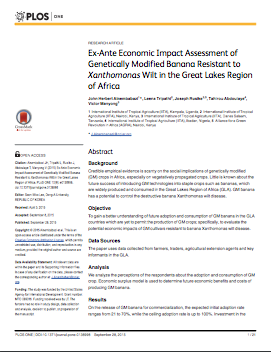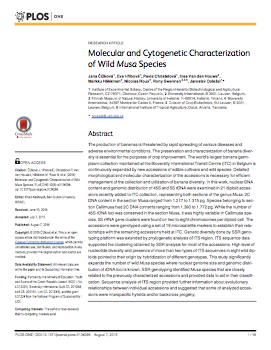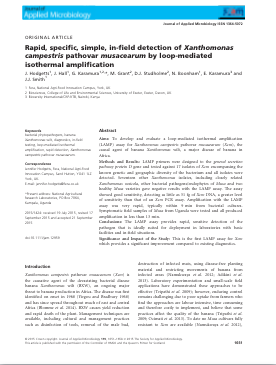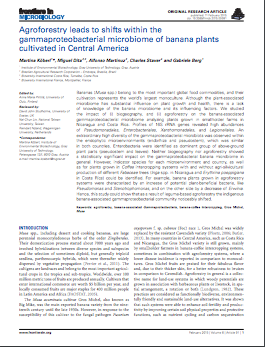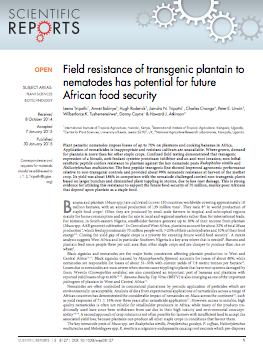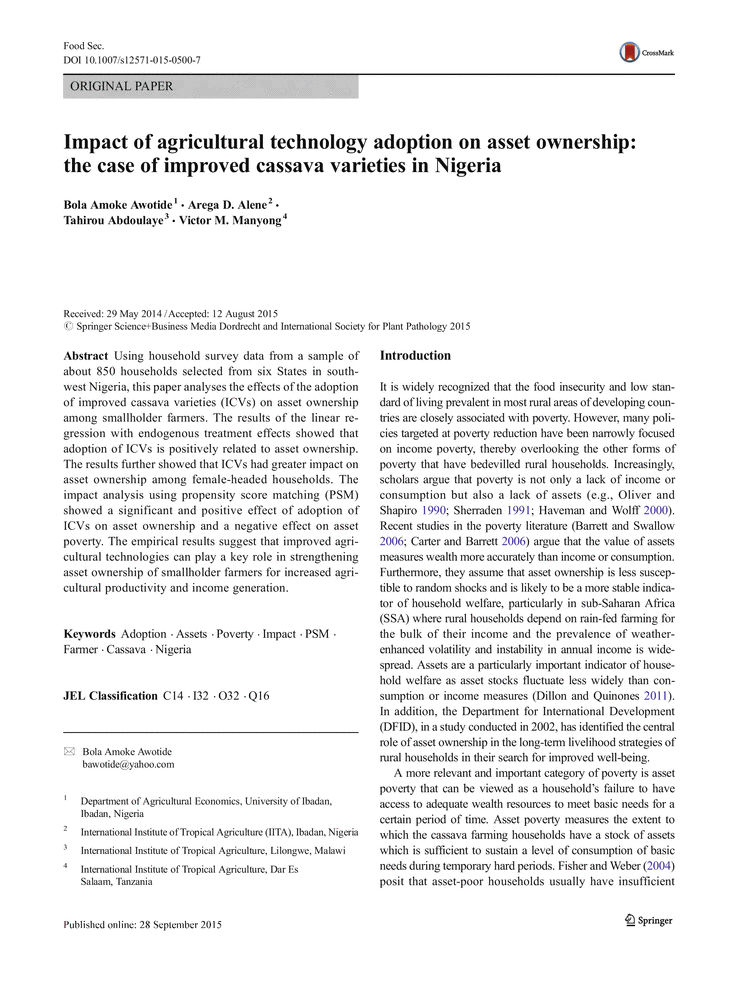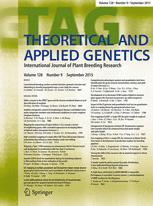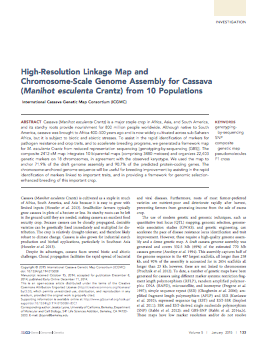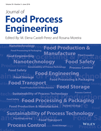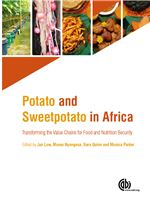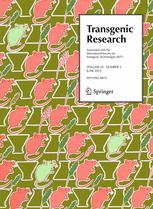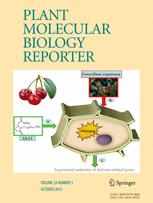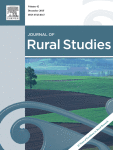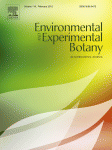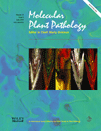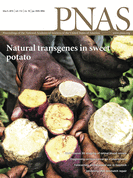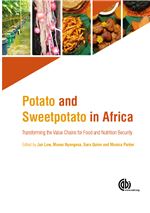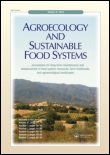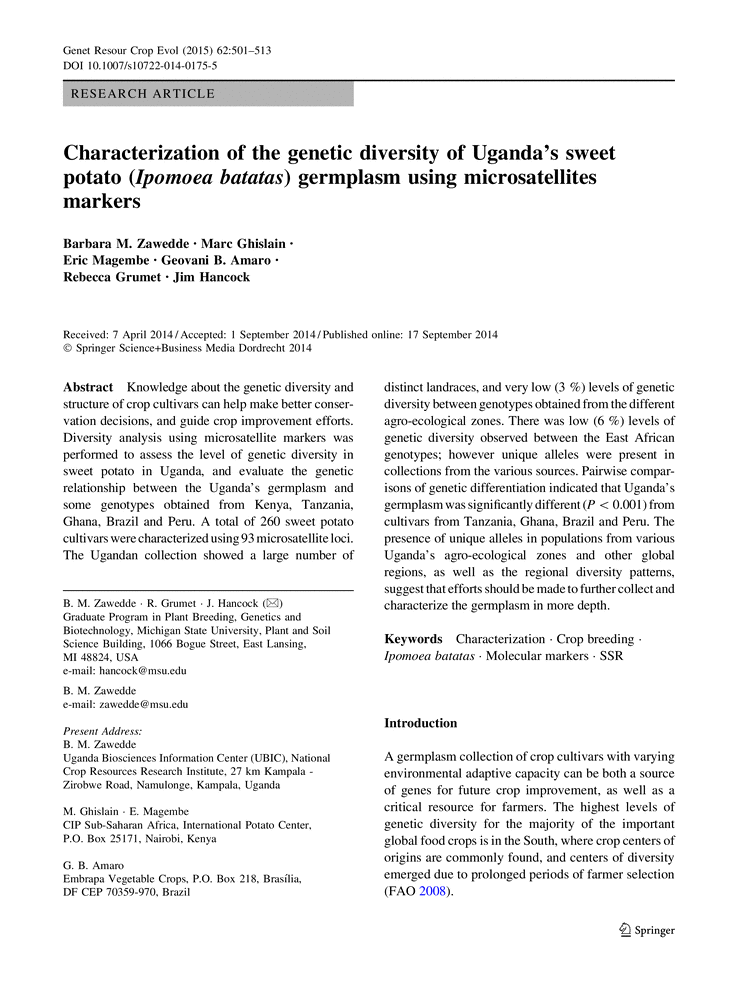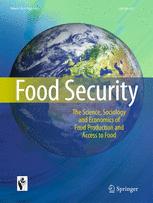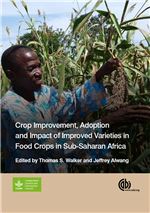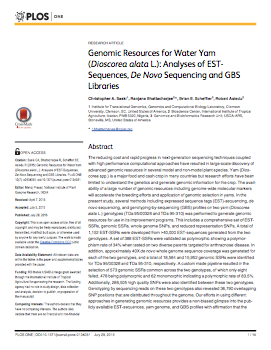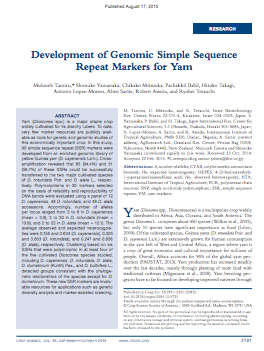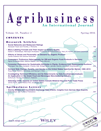Dashboard
CGIAR Research Program on Roots, Tubers and Bananas in 2015
RTB at a glance
The CGIAR Research Program on Roots, Tubers and Bananas (RTB) was launched in 2012 to harness the untapped potential of banana, plantain, cassava, potato, sweetpotato, yam, and other root and tuber crops to improve food security, nutrition and livelihoods. It brings together the expertise and resources of five centers: the International Potato Center (CIP), which leads the program, Bioversity International (Bioversity), the International Center for Tropical Agriculture (CIAT), the International Institute of Tropical Agriculture (IITA) and Centre de Coopération Internationale en Recherche Agronomique pour le Développement (CIRAD), which represents several other French partners in the research program. They have teamed up to collaborate on common issues affecting the RTB crops, mobilize complementary expertise and resources, avoid duplication of efforts, and create synergies to increase the benefits of their research and interventions for smallholder farmers, consumers, and other actors involved in root, tuber and banana value chains.
In 2015 RTB began the first year of a two-year extension period for Phase I. This gave time to strengthen and expand the program’s network of partners and improve management, whilst retaining organization around seven disciplinary Themes1. RTB finalized the move to a new program structure, based on flagship projects (FPs) and clusters of activities (cluster), starting from January 2016. FPs and cluster business cases were laid out by RTB scientist teams, including partners, and were subjected to an intensive external review process in May/June 2015. Detailed feedback from this review, the Independent Evaluation Arrangement review, and donors, as well as broad discussions among the RTB teams, informed the cluster design, their integration into FPs and the new program structure. This laid the groundwork for the submission of the Preproposal for RTB Phase II, which was highly rated by the CGIAR Independent Science and Partnership Council.
RTB centers broadened their collaborations to 366 partners, including 91 national agricultural research organizations, 102 academic and advanced research institutions, 28 non-governmental organizations, and 45 private sector companies.
In 2015 the program had eight ongoing, internally funded competitive grants, guided by RTB Theme leaders, on discovery research and cross-center and cross-crop technological innovations, as well as four ex-post impact assessment studies. Much of the results of this research is presented in the body of this report.
The results-based management (RBM) pilot, which began in 2014, continued with banana Xanthomonas wilt, potato seed, and next-generation breeding. The pilot was extended to small-scale cassava processing in 2015 with two workshops in Nigeria, to co-develop an impact pathway and shared monitoring and evaluation. To support RBM, RTB together with the CGIAR Research Program on Dryland Systems developed a planning, monitoring, evaluation, and learning information technology platform.
RTB’s targets, known as Intermediate Development Outcomes (IDOs), are fully aligned with the Sustainable Development Goals (SDGs).
1Theme 1: Unlocking the value and use potential of genetic resources; Theme 2: Accelerating the development and selection of cultivars with higher, more stable yield and added value; Theme 3: Managing priority pests and diseases; Theme 4: Making available low-cost, high-quality planting material for farmers; Theme 5: Developing tools for more productive, ecologically robust cropping systems; Theme 6: Promoting post-harvest technologies, value chains, and market opportunities; and Theme 7: Enhancing impact through partnerships.
RTB targets and their alignment with the SDGs
SDGs |
IDOs |
RTB Targets (2022) |
 |
Increased incomes and employment | 20,000,000 people (50% women) increased their income |
| 30,000 small and medium enterprises operating profitably in the RTB seed and processing sectors | ||
| Increased productivity | 8,000,000 farm households increased RTB crop yield through the adoption of improved varieties and sustainable management practices | |
 |
Improved diets for poor and vulnerable people | 10,000,000 people (50% women) have improved their diet quality |
 |
Enhanced benefits from ecosystem goods and services | 1,900,000 ha of current RTB crops production area converted to sustainable cropping systems |
| More sustainably managed agro-ecosystem | ||
 |
Mitigation and adaptation achieved | Capacity to deal with climate risks and extremes increased for at least 2,000,000 HH |
| Equity and inclusion achieved | At least 35% increase in # of female and young beneficiaries of at least 700,000 HH perceived to have better control over assets and resources | |
| Enabling environment improved | Individual capacities improved for at least 9,500 individuals (50% women) in research for development partner organizations | |
| Capacity for innovation increased in at least 60 development-focused organizations, including women’s networks and alliances | ||
| At least 5 partnership and scaling models tested in a minimum of 5 target countries and adjusted to be fit for purpose | ||
| National partners and beneficiaries enabled | Regulatory frameworks, policies, and national programs in relevant areas under implementation in at least 20 country per policy change |
Crosscutting Theme
Integrating gender to make crop research more effective
While moving forward on research to improve the yield and value of roots, tubers and bananas, RTB made significant progress on the crosscutting priority of integrating gender into its research, which will make RTB’s work more effective and equitable.
A concerted effort to mainstream gender during the research program’s first years has resulted in a growing list of gender-responsive research. For example, six graduate students from gender and development programs at US and Canadian universities worked with RTB scientists in 2015 to integrate gender analysis into their agricultural research, thanks to an RTB-university partnership.
The students’ contributions ranged from identifying gender-differentiated variables that influence the adoption of improved banana cultivars in Uganda to studying women’s role in cassava pest management in Laos and adapting gender sensitive farmer business schools in Ecuador.
Researchers from Bioversity, IITA and national partners developed and implemented a methodology for assessing the roles of gender norms and practices in banana farming and disease management at nine pilot sites in Sub-Saharan Africa, which resulted in gender-responsive guidelines for the management of banana bunchy top disease. CIP researchers developed a gender-responsive manual for participatory varietal selection (PVS) in potato and a PVS training module that was tested in Ethiopia, whereas IITA implemented a gender-responsive PVS methodology for yam with national partners in Ghana and Nigeria.
CIP developed a prototype guide to integrating gender into the participatory market chain approach that is being field tested under a joint initiative between RTB and the CGIAR Research Program on Policies, Institutes and Markets. CIAT, CIRAD, IITA, Natural Resources Institute and national partners in Benin, Cameroon, Nigeria, Sierra Leone and Tanzania completed a gender-differentiated assessment of consumer preferences for processed cassava products. These and other gender-responsive initiatives under RTB will promote more equitable access to technologies and knowledge being developed.
Harnessing genetic resources
Unlocking the value and use potential of genetic resources, and Accelerating the development and selection of cultivars with higher, more stable yield and added value
 RTB undertook an array of efforts to tap the potential of crop genetic resources for improving food security and incomes in 2015, including the use of high-throughput genotyping, phenotyping and metabolite analysis to accelerate and enhance crop improvement. Multi-center research made progress toward linking high-density genomic data to traits in cassava and banana, while genomic data were applied to potato improvement and genomic sequencing began for sweetpotato and yam.
RTB undertook an array of efforts to tap the potential of crop genetic resources for improving food security and incomes in 2015, including the use of high-throughput genotyping, phenotyping and metabolite analysis to accelerate and enhance crop improvement. Multi-center research made progress toward linking high-density genomic data to traits in cassava and banana, while genomic data were applied to potato improvement and genomic sequencing began for sweetpotato and yam.
Thousands of cassava accessions have been sequenced, and CIAT and IITA researchers used the data to reconstruct the history of the crop’s domestication and diversification patterns, which can help breeders to identify populations with desired traits. CIAT completed genome-wide association studies (GWAS) for cassava in Latin America and the Caribbean, and ran trials to investigate the genetic components underlying consumer preferred traits. IITA researchers increased the accuracy and reliability of genomic selection and identified genes linked to traits of interest.
Genomic data from 400 banana accessions were generated through RAD-seq and a new bioinformatics tool called scaffhunter was developed to integrate multiple sources of sequencing data for improving the banana reference genome. CIRAD, Bioversity and partners released a new version of the banana gene annotation, and version two of the reference genome assembly was released on the renovated Banana Genome Hub. Bioversity also undertook GWAS on a panel of 126 diploid banana accessions to detect genomic regions involved in parthenocarpy and female sterility.
CIP breeders used genomic data to select true seed potato progenies of 24 families from crosses between parents with neutral photoperiod and earliness under warm temperatures that are undergoing field trials in Uzbekistan and Peru. In sweetpotato, the sequencing of 250 drought-tolerant and 250 drought-susceptible accessions marked the first step toward locating the genes responsible for drought tolerance. In the coming years, genomic and metabolite data will increasingly be used to enhance crop improvement.
- New generation of CIP-bred potato varieties help farmers cope with climate change
- Getting women’s preferences into the banana breeding pipeline
 In 2015, two virus-resistant potato varieties – salt-tolerant CIP-301029.18 and salt-and heat-tolerant CIP-396311.1 – were evaluated in coastal districts of Bangladesh where soil salinity is a growing threat. They had higher yields than popular varieties and were recommended for release, which means they will soon join a growing cadre of CIP-bred, climate-smart potato varieties that are helping farmers produce food in difficult environments that will become more challenging as the atmosphere warms.
In 2015, two virus-resistant potato varieties – salt-tolerant CIP-301029.18 and salt-and heat-tolerant CIP-396311.1 – were evaluated in coastal districts of Bangladesh where soil salinity is a growing threat. They had higher yields than popular varieties and were recommended for release, which means they will soon join a growing cadre of CIP-bred, climate-smart potato varieties that are helping farmers produce food in difficult environments that will become more challenging as the atmosphere warms.
In recent years, CIP breeders have prioritized developing heat-, drought- and salt-tolerant potato varieties from CIP’s lowland tropics virus-resistant (LTVR) population, some of which are already being grown by farmers in countries such as Kenya, India and Vietnam. In 2015, the CIP Genebank began sending germplasm from a new, more robust generation of approximately 80 LTVR varieties to national agricultural research organizations in African and Asian countries where environmental stresses that are expected to intensify under climate change are already hindering smallholders’ ability to produce food.
Provision & management of high quality planting material
Improving the management of priority pests and diseases,
and Making available low-cost, high quality planting material for farmers
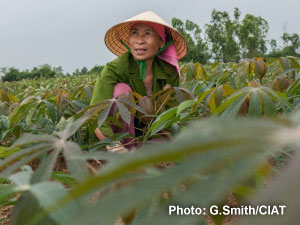 Pests and diseases cause major crop loss in developing countries and they constitute an especially serious threat for root, tuber and banana crops, which are propagated vegetatively – by planting tubers, suckers, stems or vine cuttings. This means that pests and pathogens are often passed from one planting cycle to the next, or one field to another, via planting material. RTB has addressed major pest and disease threats through initiatives that bring together experts from multiple centers and partners. These initiatives include an effort to assess the risks posed by RTB-critical pests under climate change and cross-crop research on the accumulation of pathogens in planting material, known as seed degeneration. RTB also supports efforts to improve the management of specific diseases, such as banana Xanthomonas wilt disease, an effective management package for which is being scaled out in Central Africa.
Pests and diseases cause major crop loss in developing countries and they constitute an especially serious threat for root, tuber and banana crops, which are propagated vegetatively – by planting tubers, suckers, stems or vine cuttings. This means that pests and pathogens are often passed from one planting cycle to the next, or one field to another, via planting material. RTB has addressed major pest and disease threats through initiatives that bring together experts from multiple centers and partners. These initiatives include an effort to assess the risks posed by RTB-critical pests under climate change and cross-crop research on the accumulation of pathogens in planting material, known as seed degeneration. RTB also supports efforts to improve the management of specific diseases, such as banana Xanthomonas wilt disease, an effective management package for which is being scaled out in Central Africa.
RTB initiatives to improve disease management often include the establishment of clean seed systems. CIAT, for example, has promoted thermotherapy for producing disease-free plantain and banana seed as part of efforts to control Moko bacterial wilt. CIP has long promoted clean seed systems to prevent yield loss from the accumulation of viruses in potato and an impact study of an intervention in Kenya that helped Kisima Farms Ltd. begin producing certified potato seed determined that it benefited approximately 23,000 smallholders between 2010 and 2014. Even more farmers are likely to benefit from a potato seed initiative launched by the Government of Ecuador in 2015 using CIP-validated, aeroponic propagation technology and guidance from CIP researchers. The government’s goal is to expand the area planted with disease-free seed to approximately 30% of the potato-growing area in Ecuador by 2018. Such private and public uses of the technologies that RTB centers develop and disseminate confirm the value of RTB’s research for development.
- Sweetpotato virus database offers new tool for controlling yield loss
- Breaking the bottleneck for sweetpotato planting material
- Research provides new insight on managing seed degeneration
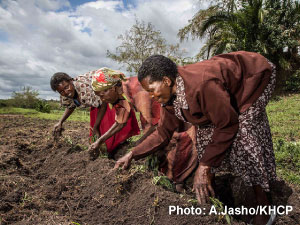 The accumulation and synergistic effect of multiple viruses simultaneously affecting sweetpotato constitute one of the worst biotic constraints for African farmers. CIP researchers consequently contributed to the creation of an interactive, online database of viruses affecting sweetpotato in Sub-Saharan Africa (SSA) – known as the Pan-African Sweetpotato Virome – in order to help breeders develop virus-resistant varieties and predict and control the threat posed by viruses.
The accumulation and synergistic effect of multiple viruses simultaneously affecting sweetpotato constitute one of the worst biotic constraints for African farmers. CIP researchers consequently contributed to the creation of an interactive, online database of viruses affecting sweetpotato in Sub-Saharan Africa (SSA) – known as the Pan-African Sweetpotato Virome – in order to help breeders develop virus-resistant varieties and predict and control the threat posed by viruses.
The database was developed in collaboration with the Boyce Thompson Institute at Cornell University. It contains information on viruses identified in more than 1,600 sweetpotato samples collected in farmers’ fields in 10 SSA countries, and includes a map of field locations and photos of infected plants. It can be used to guide breeding efforts, identify high-risk areas, and monitor the emergence of novel viral variants. It will also serve as a model for a new database on the potato virome (the viruses infecting potato) in Peru.
Adding value through post-harvest & cropping innovations
Developing tools for more productive, ecologically robust cropping systems,
and Promoting postharvest technologies, value chains and market opportunities
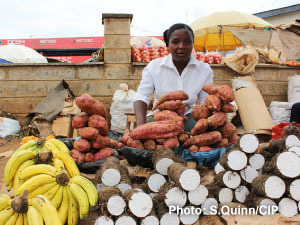 While supporting research on the diversification of cropping systems, RTB made major commitments to improving the postharvest handling and processing of roots, tubers and bananas, which can help smallholders access better markets, improve the incomes of value-chain participants, and create employment. RTB crops are perishable, creating special challenges for value chain interventions, but a three-year, multi-center project to improve postharvest handling and utilization in Uganda (RTB-ENDURE) is testing strategies for reducing postharvest loss in banana, extending cassava shelf life, improving potato storage, and creating silage from sweetpotato leaves and other byproducts that can be used as pig feed – all of which have potential for scaling out on a regional level. Cassava is especially problematic for farmers and retailers because its roots undergo rapid postharvest physiological deterioration (PPD). A south-south knowledge sharing trip organized by CIAT, CIRAD and IITA allowed seven members of the RTB-ENDURE cassava team to travel to CIAT headquarters in Colombia and learn about PPD control methods such as waxing roots. One practice that was quickly disseminated in Uganda is the pruning of plants six days prior to harvesting roots, which provides protection from PPD and makes roots sweeter.
While supporting research on the diversification of cropping systems, RTB made major commitments to improving the postharvest handling and processing of roots, tubers and bananas, which can help smallholders access better markets, improve the incomes of value-chain participants, and create employment. RTB crops are perishable, creating special challenges for value chain interventions, but a three-year, multi-center project to improve postharvest handling and utilization in Uganda (RTB-ENDURE) is testing strategies for reducing postharvest loss in banana, extending cassava shelf life, improving potato storage, and creating silage from sweetpotato leaves and other byproducts that can be used as pig feed – all of which have potential for scaling out on a regional level. Cassava is especially problematic for farmers and retailers because its roots undergo rapid postharvest physiological deterioration (PPD). A south-south knowledge sharing trip organized by CIAT, CIRAD and IITA allowed seven members of the RTB-ENDURE cassava team to travel to CIAT headquarters in Colombia and learn about PPD control methods such as waxing roots. One practice that was quickly disseminated in Uganda is the pruning of plants six days prior to harvesting roots, which provides protection from PPD and makes roots sweeter.
Cassava is widely used in processed foods, and RTB researchers have developed strategies for improving processing efficiencies and using waste from processing plants in livestock feed, whereas a multi-country study of African consumer preferences for processed cassava products provided insights that can benefit processors and widen smallholder access to those markets. While Bioversity and IITA have facilitated market opportunities for banana growers, CIP has helped smallholder potato and sweetpotato growers gain access to markets for French-fries and baked goods. In fact, CIP’s promotion of sweetpotato purée as a substitute for flour in baked goods was so successful in East Africa that the practice is currently being promoted in West Africa.
- ‘Waste to wealth’ technology turns cassava peels into livestock feed
- Women benefit from public private partnership for sweetpotato biscuits
- Consumer preferences guide cassava breeding and processing
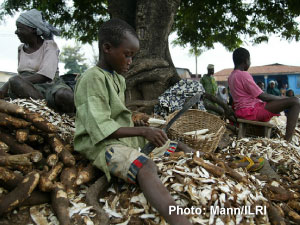 Cassava peels discarded during processing – approximately 20% of root weight –constitute an environmental hazard and a huge loss of value. RTB partnered with the CGIAR Research Programs Humidtropics, and Livestock and Fish to develop a technology for turning cassava waste into a dried, high-quality cassava peel (HQCP) mash that can be used in livestock feed mixtures – a breakthrough that will improve profitability and create jobs.
Cassava peels discarded during processing – approximately 20% of root weight –constitute an environmental hazard and a huge loss of value. RTB partnered with the CGIAR Research Programs Humidtropics, and Livestock and Fish to develop a technology for turning cassava waste into a dried, high-quality cassava peel (HQCP) mash that can be used in livestock feed mixtures – a breakthrough that will improve profitability and create jobs.
Multiple centers collaborated to develop a quick and cost-effective technology, while researchers estimated the product’s nutritional value and expected price: approximately half the cost of maize. Feed millers found that the HQCP mash is a suitable substitute for 15% of maize in livestock feed and financed feeding trials with chicken and sheep that produced encouraging results. With 14 million tons of cassava peels discarded annually in Nigeria alone, the transformation of that waste into animal feed could reduce maize imports, generate profits and employment, and reduce pollution.
Selected publications
Banana
Cassava
Potato
Sweet potato
Yam
Partners
Partnership is central to international agricultural research for development precisely because collaboration mobilizes research results through bringing together diverse actors at international, regional, national and local levels to produce results. Partnerships are a key part of most activities under the CGIAR Research Program on Roots, Tubers and Bananas (RTB) and form an intrinsic part of the theories of change which make outcomes possible, with the scale and scope of partnerships changing along the research to the development continuum.
In 2015, RTB worked with 366 formally established partners, including private sector, national agricultural research organizations, advanced research institutions, academic institutions, governmental and non-governmental organizations. However, innumerable community based organizations and farm households not individually listed here were also central to the program’s success.
Donors
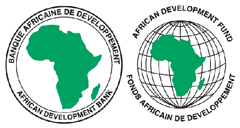
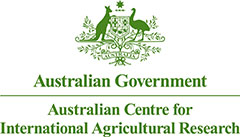









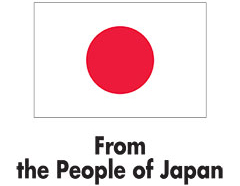
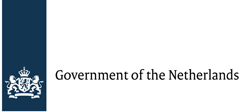

 Government of Tanzania
Government of Tanzania
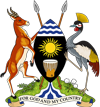
Government of Uganda



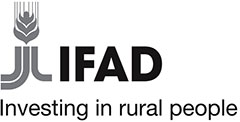
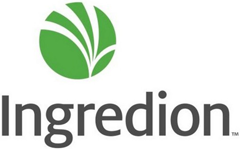
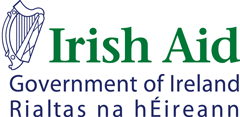




RTB 2015 Financial Report
RTB started 2015 with a newly allocated Window 1 (W1) and Window 2 (W2) budget of US$ 29.6M, which was adjusted during the year to US$ 21.9M after funding cuts in March and October that totaled US$ 7.7M.
After the reductions in W1 and W2, the total 2015 budget for the program was US$78.2M: US$21.9M (28%) funded from W1 and W2, and US$56.3M (72%) from Window 3 (W3), bilateral funds and RTB participant centers’ own funds.
CGIAR Funding Windows
Windows 1&2 funds are provided by the CGIAR to RTB for allocation across the agreed product portfolio. Window 1 funds are allocated by the CGIAR Consortium to different CRPs including RTB, while Window 2 funds are designated by donors specifically to RTB.
Window 3 funds are allocated directly to CGIAR Centers by donors and are mapped into RTB when they are consistent with the RTB product portfolio. Window 3 includes a deduction of 2% of the total budget as contribution to the CGIAR Consortium.
Bilateral funds are contracts directly signed between a center and a donor and mapped into RTB.
The distribution of budget by funding sources between 2012 and 2015 shows a changing contribution of W1 and W2 to the RTB annual budget. While in 2012 the share of W1 and W2 was 44%, this fell to 28% in 2015 – with a respective increase in W3 and bilateral funds, from 56% to 72%, in the same period.
2015 Expenditure
RTB total expenditure across all funding sources in 2015 was US$72.2M. This represents execution of 92% of the budget: US$20.4M were spent from W1 and W2, and US$51.8M from W3, bilateral and center funds.
Expenditure for gender research was US$4.4M (94% of gender budget execution), representing 6% of RTB total expenditure in 2015. Management expenditure of US$1.5M represents 2% of the RTB total expenditure (74% of management budget execution), similar to 2014.
The figure below shows the budget and expenditure by Theme. RTB had an average execution of 91% of each Theme budget, with the exception of Theme 6 which was overspent by 3%, due to the implementation of new W3 and bilateral projects not previously included in the budget.
Trends in expenditure
Compared to 2012, RTB presented an overall increase of 32% in expenditure (US$72.2M in 2015 vs. US$54.6M in 2012), with a marginal reduction of 4% from 2014 to 2015 (US$72.2M in 2015 vs. US$75.4M in 2014), mainly due to uncertainties of funds from W1 and W2. The cumulative expenditure reached US$271.2M over the four years of the program (US$103.2M from W1 and W2, and US$168.0M from W3, bilateral and center funds).
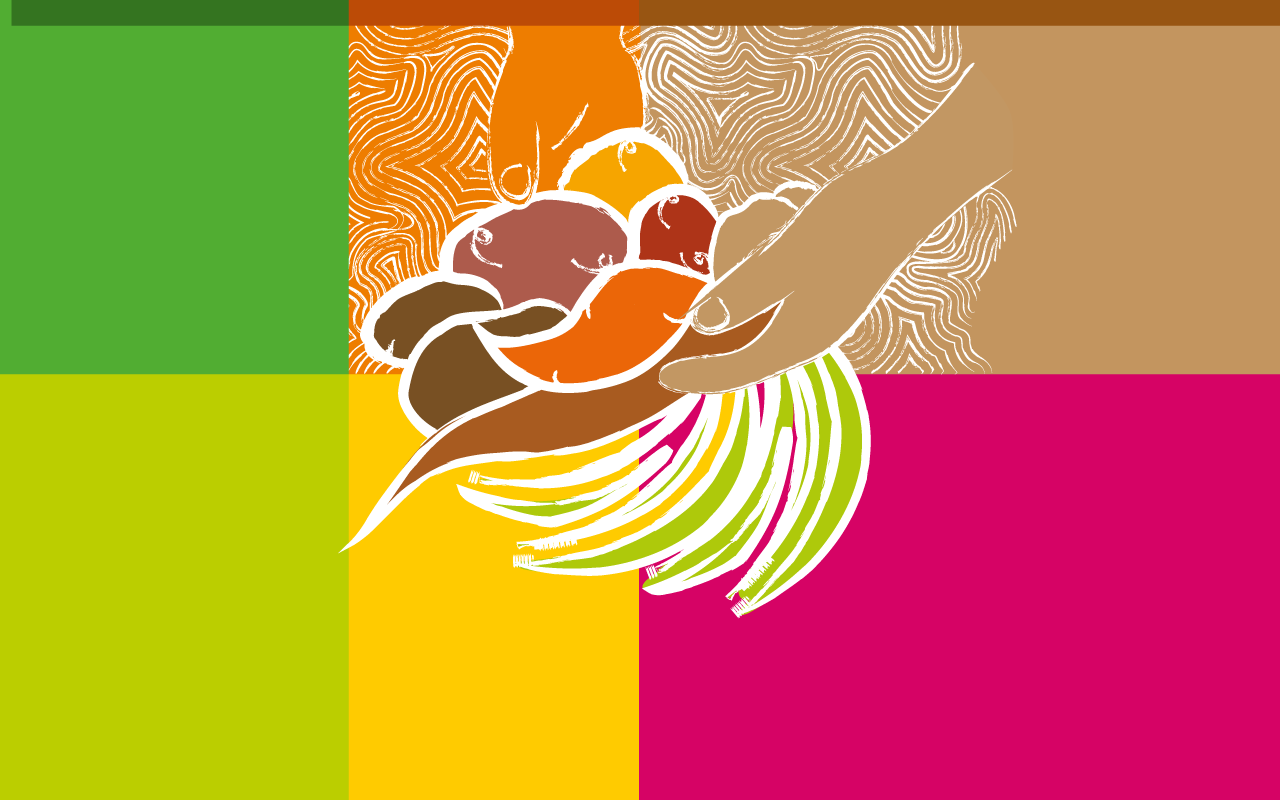

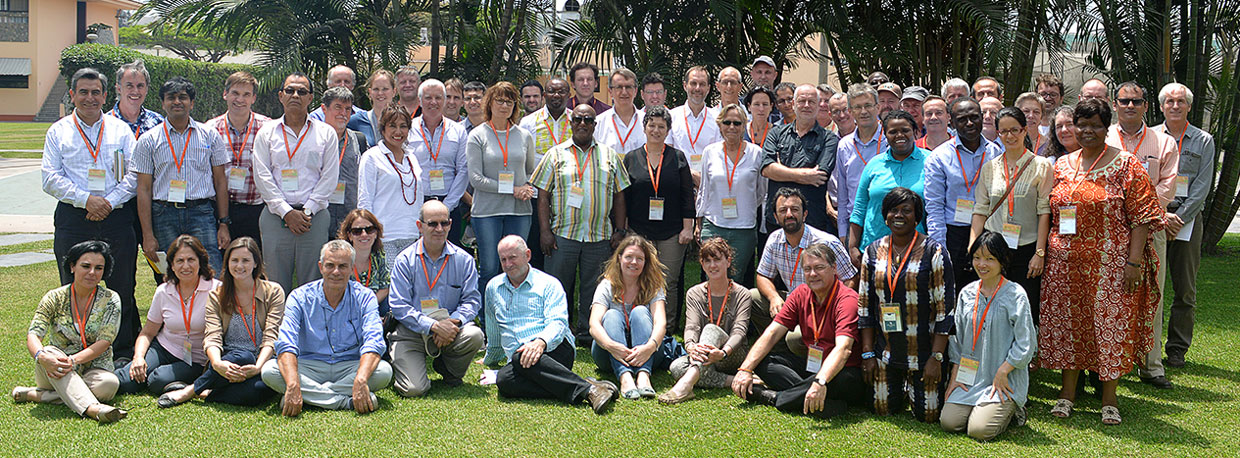
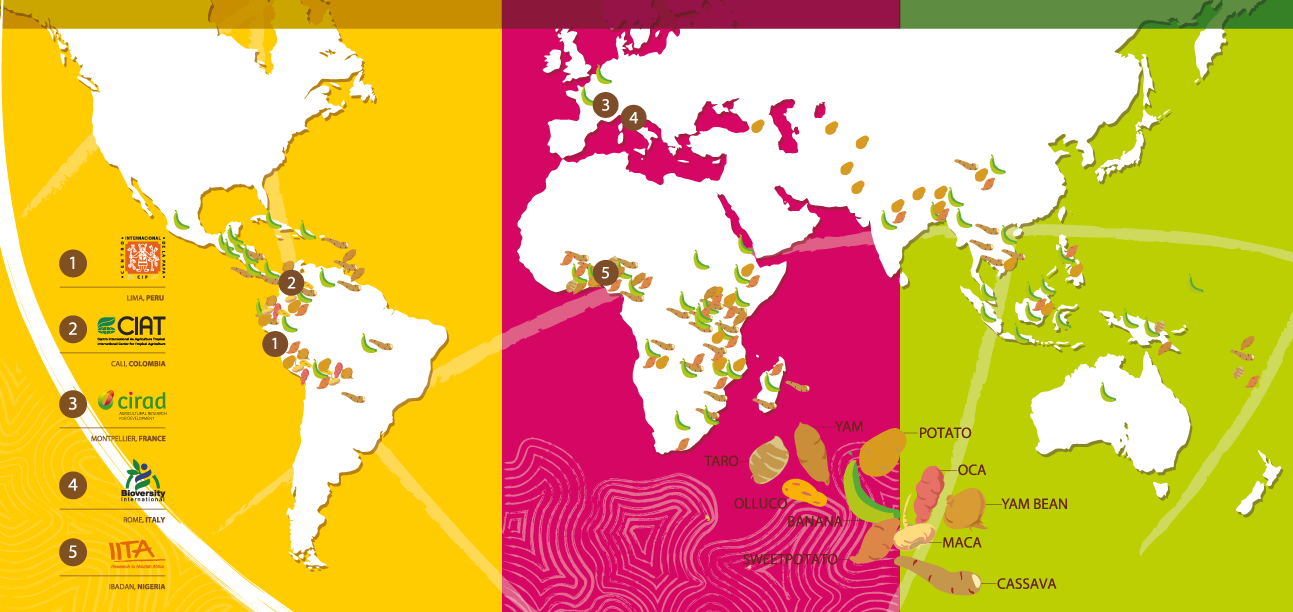


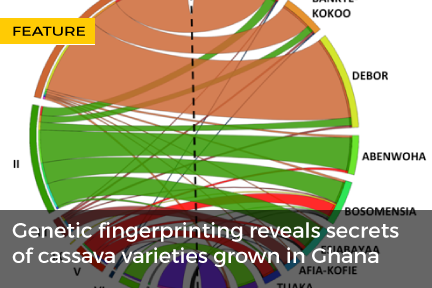
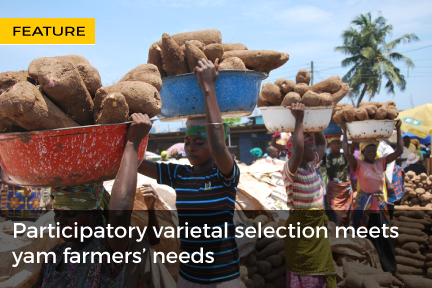
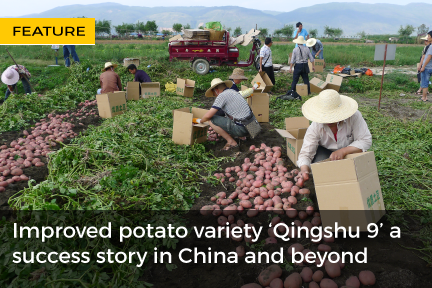
 In order to ensure that the banana varieties developed by IITA and Uganda’s National Agricultural Research Organization (NARO) have the traits that men and women farmers want, RTB scientists developed a methodology for a gender-differentiated baseline study that was undertaken in collaboration with NARO and the Agricultural Research Institute in Tanzania in 2015 and early 2016.
In order to ensure that the banana varieties developed by IITA and Uganda’s National Agricultural Research Organization (NARO) have the traits that men and women farmers want, RTB scientists developed a methodology for a gender-differentiated baseline study that was undertaken in collaboration with NARO and the Agricultural Research Institute in Tanzania in 2015 and early 2016.
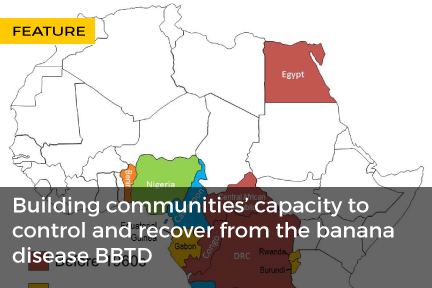
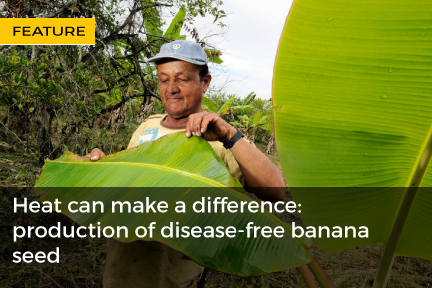
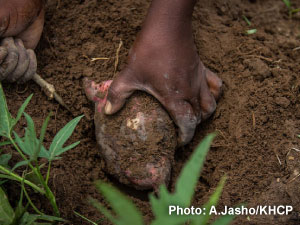 Farmers in SSA often can’t get enough sweetpotato vines for planting when seasonal rains begin, since vines and roots don’t survive the dry season, limiting adoption. CIP has developed and tested a root-based vine multiplication system called Triple S (sand, storage and sprouting) in Uganda, Tanzania and Ethiopia to overcome this bottleneck, with promising results.
Farmers in SSA often can’t get enough sweetpotato vines for planting when seasonal rains begin, since vines and roots don’t survive the dry season, limiting adoption. CIP has developed and tested a root-based vine multiplication system called Triple S (sand, storage and sprouting) in Uganda, Tanzania and Ethiopia to overcome this bottleneck, with promising results.  A cross-center initiative to improve the understanding and management of seed degeneration – reductions in yield and quality due to the accumulation of pathogens in planting material over successive planting cycles – has shed new light on degeneration’s dynamics.
A cross-center initiative to improve the understanding and management of seed degeneration – reductions in yield and quality due to the accumulation of pathogens in planting material over successive planting cycles – has shed new light on degeneration’s dynamics.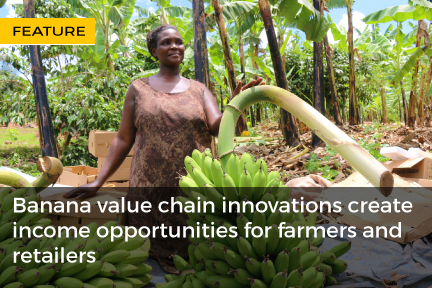

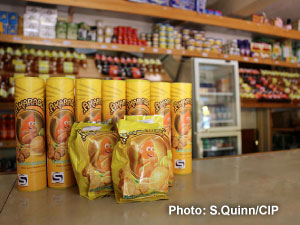 An assessment of a CIP-coordinated, public-private venture in Rwanda that launched the Golden Power Biscuit and other baked products made with vitamin A-rich orange-fleshed sweetpotato (OFSP) purée found that the venture improved the earnings of both the company that produces the snacks and the smallholders who supply it with sweetpotato roots – especially women.
An assessment of a CIP-coordinated, public-private venture in Rwanda that launched the Golden Power Biscuit and other baked products made with vitamin A-rich orange-fleshed sweetpotato (OFSP) purée found that the venture improved the earnings of both the company that produces the snacks and the smallholders who supply it with sweetpotato roots – especially women.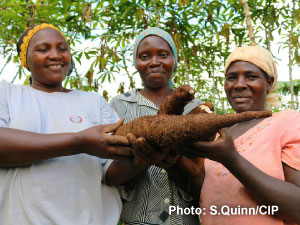 In Africa, cassava is commonly transformed into products ranging from traditional foods such as gari to flour or starch for food industries. Yet little is known about which varieties and processes result in cassava products that consumers prefer. In an effort to strengthen local processing and widen or facilitate smallholder access to the markets it creates, a collaborative initiative by CIAT, CIRAD, IITA, Natural Resources Institute (NRI) and national partners assessed consumer preferences and gender differences in the perception of cassava product quality in five countries.
In Africa, cassava is commonly transformed into products ranging from traditional foods such as gari to flour or starch for food industries. Yet little is known about which varieties and processes result in cassava products that consumers prefer. In an effort to strengthen local processing and widen or facilitate smallholder access to the markets it creates, a collaborative initiative by CIAT, CIRAD, IITA, Natural Resources Institute (NRI) and national partners assessed consumer preferences and gender differences in the perception of cassava product quality in five countries.
